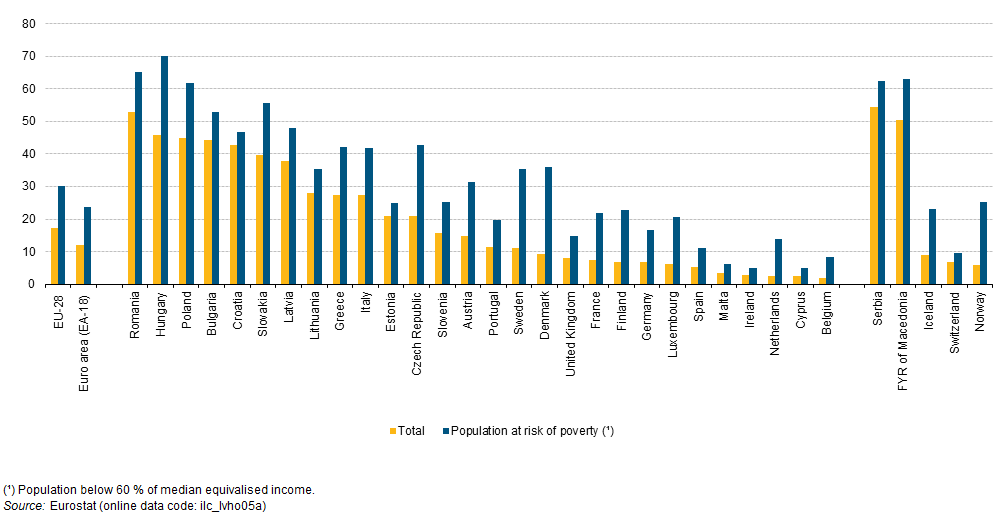Housing shortage in Europe – a problem of the past?
If we asked people in Europe what was the issue they considered to be particularly problematic in their everyday life, in most cases the availability of housing wouldn’t be probably among the top answers. Other concerns, including widespread unemployment among the youth as well as uncertainty about the future in a world strongly dependent upon the unpredictable financial markets, have recently gained very much importance. However, it can be shown that to treat the shortage of housing in Europe as a marginal issue would be premature and wrong.
A serious deficit of housing plagued many European states during the first decades after the II world war. Western European countries like Germany or France responded to the challenge with large-scale construction programmes generously subsidized by the state. When the most urging needs were satisfied, there was a shift towards a marked-based model with the role of the state limited to providing means-tested support for low-income groups. However, in the course of the so-called rollback of the welfare state this support has been gradually reduced.
Large housing construction schemes were also pursued in the socialist states, yet due to limited financial resources they lead to much less satisfactory results. In consequence, after the fall of socialism one of the main challenges was to increase the availability of housing. The solution that was chosen relied typically on a market-based model with limited involvement of the state, which was partly a result of the prevailing neoliberal ideology, and partly a pragmatic consequence of financial shortages. This model led to a substantial increase in new housing supply, but not in all the cases did it solve the problem of housing shortage.
The outcomes of the old division of Europe are visible until the present day in terms of housing conditions. With some exceptions, the share of population living in overcrowded dwellings in former socialist states is in the range of 20 to 40%, while in the FYR of Macedonia, Romania and Serbia it even exceeds 50%. It can be hoped that with gradually increasing supply of new housing, the problem of overcrowding would be reduced, but the passive position of the states towards housing policy remains problematic. Remarkably, also some Mediterranean states including Italy and Greece are characterized by high rates of overcrowding, and considering populations at risk of poverty overcrowding rates are close to or exceed 20% in most countries of western and northern Europe.
As we see, in large parts of Europe there exists still a housing shortage in a “classic” sense, meaning that there is no sufficient housing space available in physical terms. However, considering the fact that the living realities are changing, one should perhaps consider the possibility of rethinking the definition of housing shortage. In my view, while the physical deficits of housing space are diminishing, the economic deficits tend to increase. So, one should perhaps think about housing shortage more in terms of lacking affordable housing space. According to Eurostat data (2012), an 11% share of households in the EU spent 40% of more of their disposable income or housing. That share was substantially higher in Greece (36.9%), but also in countries like Denmark or Germany it amounted to 18.9% and 16.4%, respectively. So, it appears that the problem of high housing expenditures is not limited to the less affluent countries only.
This problem can potentially affect the younger generation in a particularly large extent. In comparison to the past, when the physical shortage of habitable dwellings was a particular challenge, nowadays the quality and affordability of the stock appear as crucial issues. While the parents and grandparents of the generation now entering the housing market could rely on diverse forms of support from the government, these options have generally become more limited now. Considering also the unsecure employment conditions, the younger generation may face difficulties to pay the rent or mortgage even for modest apartments.
Finally, one can ask what actions could be undertaken to tackle the new dimension of housing shortage. While some policy options are only available at the higher levels of government, some solutions can also be pursued locally. One option, for example, is to increase density in places where land values are particularly high. Another choice is to create residential zones in places where land is cheaper (in secondary cities, for example), and connect them with major cities by efficient public transit. The choice of available solutions is in fact quite large, but the crucial point seems to be to put housing affordability high on cities’ planning agendas, which so far does not seem to be always the case.
When you subscribe to the blog, we will send you an e-mail when there are new updates on the site so you wouldn't miss them.



Comments 1
[…] My recent post on AESOP Young Academics has the title “Housing shortage in Europe – a problem of the past?“ […]